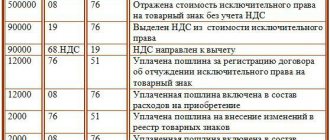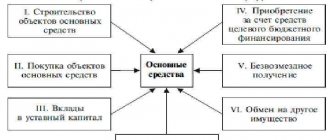Sales of services: postings
10 “Materials”, 70 “Settlements with personnel for wages”, 69 “Settlements for social insurance and security”, etc. Revenue from the provision of 90 is reflected, subaccount “Revenue” The cost of services provided is written off 20, 29, etc. VAT is charged on the cost rendered 68 “Calculations for taxes and fees”, sub-account “VAT” Expenses associated with the provision of 44 Sometimes the question arises as to what accounting entries need to be made when reselling services.
Let us immediately make a reservation that the term “resale” is not entirely applicable to services. After all, the acquisition and consumption of services is carried out simultaneously, therefore, it is impossible to buy services (i.e. consume them) and then resell them.
It may be more about the provision of services with the involvement of third parties. For example, for
Concept and types of services
Paid provision of services is an agreement between the customer and the contractor, according to which the contractor undertakes to perform the services specified in the contract, and the customer undertakes to pay for the services performed in accordance with the terms of the contract (Articles 779 and 781, Chapter 39, Part 2 of the Civil Code of the Russian Federation of January 26, 1996. N 14-FZ as amended on May 23, 2016).
Free provision of a service is the provision of a service to a counterparty without receiving payment from him (Article 423 of the Civil Code of the Russian Federation).
The contract for the provision of paid services may indicate, for example, the following services:
1C postings for services received and implemented
The debit of the account indicates the expense account, and the credit of account 60 shows subaccount 01, which in the accounting chart of accounts is called “Settlements with suppliers and contractors.”
Also, companies paying VAT draw up an invoice.
When receiving (receiving) different services, the same accounting account is not always indicated by debit; the following postings for services are generated, for example:
- For transport costs, the accounting account may be different, it could be:
- Account 44.02 “Business expenses in organizations engaged in industrial or other production activities” when transporting products of its own production by a transport organization;
- Account 26, reflected when sending correspondence when using the Internet line;
- For audit purposes, the account is indicated by debit.
How to record the implementation of works (services) in accounting
.If the organization that provides services (performs work) is a VAT payer, accrue this tax simultaneously with the recognition of revenue.
We recommend reading: Answers to sanitary minimum questions for catering workers
26, when receiving office supplies for office workers by transport supplier; - Account 44.01 “Distribution costs in organizations engaged in trading activities” when transporting sold goods to a counterparty by transport of a third-party organization; - Account
Reflect the accrual of VAT in the debit of account 90-3: Debit 90-3 Credit 68 subaccount “Calculations for VAT” - VAT is charged on the sale of work (services). If the organization received a partial (full) prepayment on account of future work (services), in accounting make the following entries for VAT calculation: Debit 51 (50) Credit 62 subaccount “Calculations for advances received” - partial (full) prepayment was received from the buyer for upcoming work (services); Debit 76 subaccount “Calculations for VAT from advances received” Credit 68 subaccount “Calculations for VAT” - VAT is charged on the prepayment amount. This procedure follows from the Instructions for the chart of accounts (accounts 68, 90). Situation: how to reflect in accounting the implementation of work that is long-term in nature (except for construction work)? In accounting reflect the implementation
Accounting entries for services rendered
The debit of the account indicates the expense account, and the credit of account 60 shows subaccount 01, which in the accounting chart of accounts is called “Settlements with suppliers and contractors.”
When receiving (receiving) different services, the same accounting account is not always indicated by debit; the following postings for services are generated, for example:
- For transport costs, the accounting account may be different, it could be:
- Account 44.02 “Business expenses in organizations engaged in industrial or other production activities” when transporting products of its own production by a transport organization;
- Account 26, reflected when sending correspondence when using the Internet line;
- For audit purposes, the account is indicated by debit.
Accounting expenses
Accounting services : what do we pay for?
If for some reason you do not have time to find an accountant before submitting your reports, but you need to report to the tax authorities, then do not despair, there is always a way out! There are companies that provide accounting services that will help solve unresolved problems. They provide all kinds of services, let's combine them into one name - accounting services . For example, a qualified specialist can fully conduct accounting and tax records or deal with a separate area of accounting.
Sometimes a client only needs help in drawing up reports. In such cases, you can also contact a firm providing accounting services . In addition, the services of firms providing accounting services are used when it is necessary to restore accounting records. For example, in a company with the departure of the chief accountant, they discovered that the documents were left in complete disarray. This is where qualified accountants from firms providing accounting services can help you.
What are accounting services written off for?
In accounting, the costs of accounting services are classified as administrative expenses (ordinary activity) (according to paragraph.
Accounting for services rendered: for novice accountants
The Tax Code especially ardently monitors the types of expenses and clearly defines: “Any expense must be justified and have a production necessity.
26, when receiving office supplies for office workers by transport supplier; - Account 44.01 “Distribution costs in organizations engaged in trading activities” when transporting sold goods to a counterparty by transport of a third-party organization; - Account
Those. directly influence the ability to conduct business” What does this give us?
This is a mental filter through which we pass every purchase, especially the purchase of services. In other words, we may have services that can be included in the financial result formula and reduce income taxes. Or there may be services that cannot be included in the formula and reduce taxable income; The company will be able to pay for such services only from its net profit.
A clear example of a service that cannot be included in the formula, but will have to be paid for out of net profit, may be the purchase of drinking water for the company’s offices, or payment for employees’ lunches in catering establishments.
And why all? Because these are not production costs.
They do not directly affect the implementation of activities.
We recommend reading: Mostransavto complaint against driver
Accounting and tax accounting
For accounting purposes, costs associated with consulting or obtaining information services must be shown according to the rules of PBU 10/99. Accounting standards classify this type of costs as expenses from ordinary activities (clause 7 of PBU 10/99). They are accumulated in the debit of account 26 or 25, 20, 44, 91 (depending on the nature of the service and the topic of the consultation, on the purpose for which this information is required). Accounting is carried out with participation in the correspondence of account 60. Recognition of costs occurs in the period when the services were actually received. Linking a transaction to the date of payment is not practiced.
In tax accounting there is no unambiguity in the recognition of information and consulting services. The Ministry of Finance indicates that these costs can be taken into account when calculating the size of the tax base for income tax (Letter No. 03-03-06/1/49967 dated 10/06/2014). The Ministry of Finance recommends that the cost of legal, information, consulting and other types of intangible services be included in other expenses that are associated with production and sales activities. The date of recognition of costs is tied to the date of settlement or receipt of documentation for subsequent settlement. It is also allowed to focus on the last day of the reporting period (p. 272 of the Tax Code of the Russian Federation).
IMPORTANT! The Ministry of Finance clarifies that the cost of such services can be included in expenses under one condition - the business entity can prove the validity of the expenses and document the fact of receiving the service.
The fact of provision and receipt of services is verified by the tax authorities through an assessment of the reality of the concluded transaction (checking the location of the organization that provided the services, their contact phone numbers, compliance of signatures in the acts). Primary documentation for business transactions can be recognized as justifying if the execution of the forms complies with legal standards (there is a complete list of mandatory details, the contents of the document coincide with the nature of the service provided).
In contracts and acts it is necessary to provide a detailed breakdown of the services provided. The use of general language (legal services or information and consulting support) is not a basis for recognizing supporting documentation as valid. In court, if there is no detail on services, the contract may be classified as unconcluded. The reason is:
- the impossibility of identifying the list of issues on which consultation was provided;
- unclear definition of the time range for performing services;
- the absence of signs by which one can trace the purpose of contacting consultants.
If the contract and act do not detail the services, this set of documents must be supplemented with a certificate or report drawn up in any form. They describe in detail the nature of the services and their composition. Along with acts, invoice forms and consultation protocols can act as primary supporting documentation.
To accept the VAT amount for deduction, you must have an invoice (registration is regulated by Article 169 of the Tax Code of the Russian Federation). The justification for the need to obtain specific services should be based on their direct impact on the company's performance. Tax authorities defend the position that expenses are unreasonable if, after their implementation, the enterprise does not have income
IMPORTANT! All costs recognized in tax accounting must have a direct impact on the amount of income received.
A dispute with regulatory authorities is possible if the content of the services provided by third parties coincides with the job functions of one of the company’s full-time specialists. For example, a company has a lawyer on staff, but the position is not vacant. If the management of the company turned for legal advice not to its specialist, but to another organization or individual, then the costs incurred in connection with this will not be justified. It is necessary to avoid duplication of duties of regular staff with intangible services.
Judicial practice proves that the position of tax authorities on the issue of justification of expenses can be successfully challenged. Court decisions indicate that only the business entity itself can assess the effectiveness of the resources spent. The reason for inclusion in the expense tax base can be either an actual increase in income associated with incurred costs, or an intention in the future to receive additional material benefits or to eliminate the occurrence of losses.
Intangible
For simplifiers, there is a closed list of costs by the amount of which the tax base can be reduced. Their list is recorded in Art. 346.16 Tax Code of the Russian Federation. Consulting services are not mentioned in this section of the Tax Code. The impossibility of offset in calculating tax according to the simplified tax system is confirmed in letters from tax authorities (for example, Letter of authorship from the Federal Tax Service of the Russian Federation for Moscow dated December 19, 2007, No. 18-11/3/ [ email protected] ).
There may be several exceptions to this rule:
- The company that received information services specializes in consulting (the provision of intangible information services is its main activity). Expenses should be included in material costs.
- Auditing, accounting or legal advice. If a dispute arises with the Federal Tax Service regarding audit information support, it is necessary to justify your position in clause 2 of Art. 1 of the Law of December 31, 2008 No. 307-FZ (in this part, the law defines that audit services are not only an audit, but also related services).
Accounting for services provided: basics
The Tax Code especially ardently monitors the types of expenses and clearly defines: “Any expense must be justified and have a production necessity. Those. directly influence the ability to conduct business” What does this give us?
This is a mental filter through which we pass every purchase, especially the purchase of services. In other words, we may have services that can be included in the financial result formula and reduce income taxes. Or there may be services that cannot be included in the formula and reduce taxable income; The company will be able to pay for such services only from its net profit.
A clear example of a service that cannot be included in the formula, but will have to be paid for out of net profit, may be the purchase of drinking water for the company’s offices, or payment for employees’ lunches in catering establishments. And why all? Because these are not production costs. They do not directly affect the implementation of activities.
Which account should account for services?
For example, a company bought goods and materials.
Spent money, but did not lose it, because “money turned into other resources.” The transfer of materials to production or household needs occurs as follows:
- Due to posting, materials are reduced by 10th account in the calculated amount and quantity
- the cost of these materials is calculated, for example, the average cost.
- and this amount comes to the cost accounts (20, 23, 25, 26, 44)
- until the end of the month, such accumulated amounts can safely be said to be expenses
But when the process of closing the month begins and these costs begin to participate in the calculation of the financial result, then they turn into the concept of expenses, i.e. these are costs taken into account for the financial result to calculate profit, from which “Income Tax” is then taken. Not all desired costs of an enterprise can be classified as expenses.
Those. not all costs can be included in the financial result formula for calculating profit.
Cost accounting: how is it done and why is it needed?
With this short review, we are opening a series of materials for those business owners who have had to deal with accounting . We will not talk about what is unlikely to be useful to you: only the most necessary and in simple words. So, let's go.
Convenient online accounting
Quick establishment of a primary account, automatic payroll calculation, multi-user mode in Kontur.Accounting
Try it
The company records its costs, for example, for staff salaries, rental or communication services, materials used in the company's work, depreciation of vehicles and equipment, on expense accounts. They are designed to save up all your expenses within a month. We don't want anything to be forgotten or lost, right?
Let's look at the main expense accounts that may be useful to you:
Account 20 is intended to account for production costs aimed at producing products or providing services. It’s called “Main Production”. This may include the cost of materials for baking buns, and the salaries of car drivers if you provide delivery services. By the way, the depreciation of these cars can be included here.
Account 26 : “General business expenses.” It takes into account administrative or management costs. Office rent or the salary of the company director should be reflected here.
Account 44 records costs associated with the sale of goods, works or services. Organizations that are engaged in trade can take into account all their costs if they do nothing else. And other companies take into account entertainment expenses, advertising expenses, salespersons’ salaries, agency fees for selling products, etc. The account is called “Sales expenses.”
Expense accounts are “closed” at the end of each month. This means that the amounts accumulated on them are written off to another account, usually to the 90th account : in addition to the accumulated expenses that came here from expense accounts, all expenses for the month are taken into account.
In addition to expenses, all monthly income also falls here. Expenses are then subtracted from income, and the resulting result, called the financial result for the month , will be the accounting profit or loss. This amount goes to another account - 99 ; it is called “Profit and Loss”, and accountants call the procedure for determining or deducing a financial result “closing the month” .
In Kontur.Accounting, all this work is automated: the service itself will generate a document, which is called: “Closing the month.” It will display the financial result, and you only need to submit primary documents on time.






